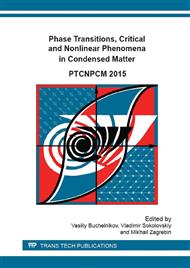p.239
p.243
p.247
p.251
p.255
p.259
p.265
p.269
p.273
Studies on Highly Porous Graphene-Like Structures as Electrode Material for Supercapacitors
Abstract:
The paper presents studies on highly porous graphene-like structures as an electrode material for supercapacitors. The experimental research was performed in inorganic (3 M sulfuric acid) and organic (1 M tetraethylammonium tetrafluoroborate in acetonitrile) electrolytes. It was found that in the inorganic medium the electrodes made on the basis of graphene-like structures possess higher specific capacitance. When increasing the potential scan rate from 5 to 100 mV/s the “electrode-electrolyte” system lost 40-80% of the capacitance. The cyclic current-voltage curves obtained for the organic electrolyte were more strongly distorted when increasing the potential scan rate, which might be related to more severe transport limitations imposed on large organic ions.
Info:
Periodical:
Pages:
259-262
Citation:
Online since:
March 2016
Price:
Сopyright:
© 2016 Trans Tech Publications Ltd. All Rights Reserved
Share:
Citation:


